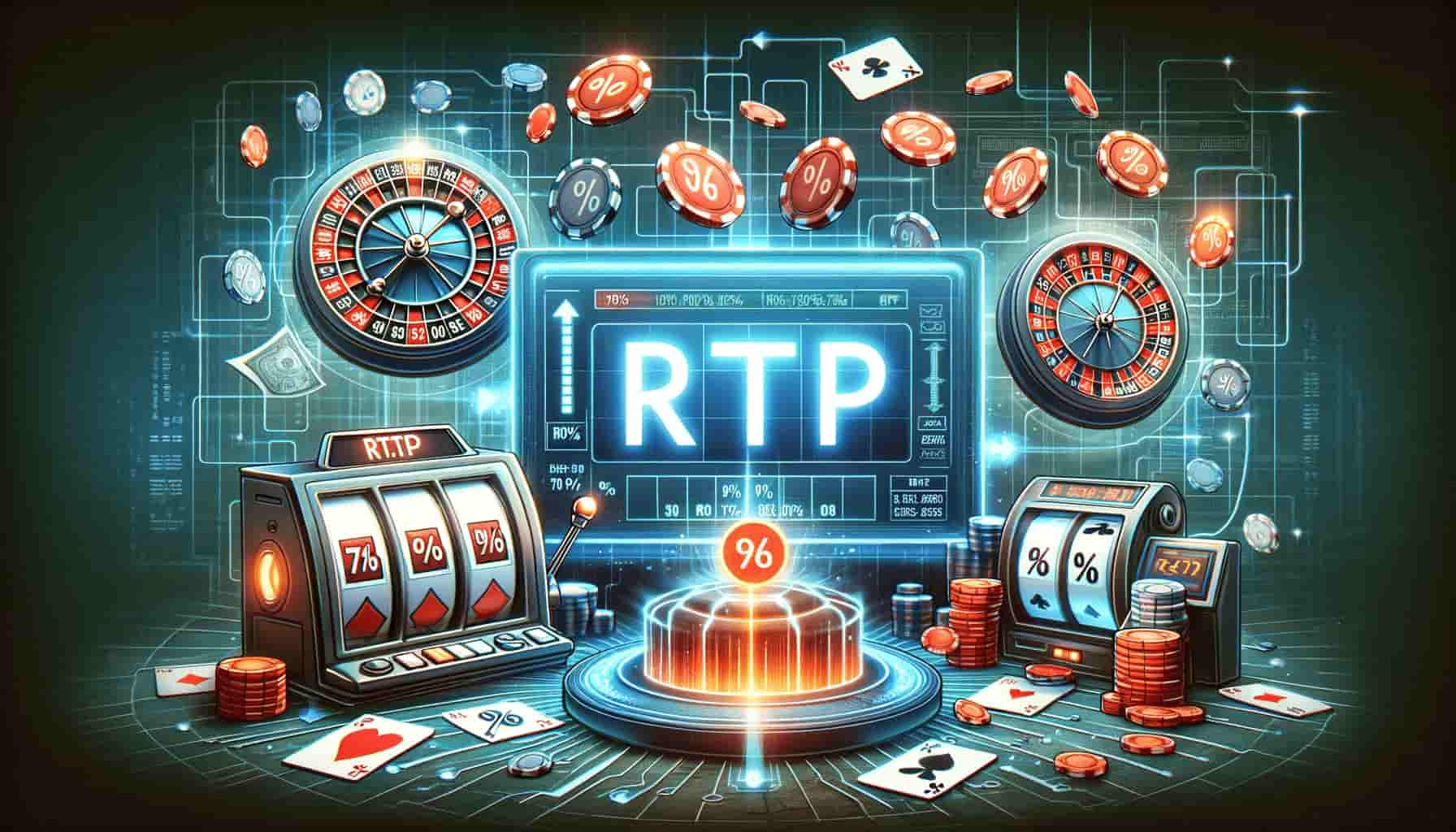
What Does RTP Mean in Online Casinos?
In the realm of gambling, the term “RTP” holds significant importance, especially in the context of online casinos. RTP, short for Return to Player, is a fundamental concept that every casino player should understand. It denotes the percentage of the total money wagered in a game that will be paid back to players over time. This metric not only guides players in assessing the potential profitability of a game but also serves as a benchmark for fairness in the casino’s offerings. Grasping the meaning of RTP is essential for players to make informed decisions, as it directly impacts their gaming experience. When players encounter the term “casino RTP,” it’s a reference to the average payout rate of the games offered by the casino. Understanding RTP helps players weigh their chances and strategize accordingly, making it a fundamental aspect of the gambling experience in online casinos.
Understanding RTP: Basics Explained
Grasping the concept of RTP, which stands for Return to Player, is essential in the online gambling landscape. RTP is a term widely used in casinos to describe the percentage of all wagered money a slot or casino game will pay back to players over time. For instance, an RTP of 95% implies that for every $100 wagered, the game is expected to return $95 to players eventually. This metric is crucial in helping players understand what they can expect from their gambling experience in terms of potential returns.
RTP is calculated based on the outcomes of thousands, if not millions, of spins or rounds in a game. It’s an average figure derived from extensive data, representing the long-term performance of a game. This statistical approach ensures that RTP reflects a realistic expectation over a significant period.
However, it’s important to distinguish between theoretical and actual RTP. Theoretical RTP is the percentage built into the game’s design and programming, indicating the expected payback over an extended period. Actual RTP, on the other hand, refers to the payback players receive in reality over a shorter period. This actual RTP can fluctuate greatly in the short term due to the random nature of gambling games. Comprehending the difference between theoretical and actual RTP is crucial for players in the online gambling arena, as it offers a more precise understanding of RTP’s implications for both short-term play and long-term gaming strategies.
Variations of RTP in Different Casino Games
In the realm of digital gaming, the term RTP, or Return to Player, plays a critical role in shaping players’ experiences and choices. RTP in gambling essentially refers to the percentage of wagered money a game will return to players over time. This figure varies widely across different types of casino games, from slots to table games, each offering distinct RTP ranges that cater to diverse player preferences.
Slots, for instance, are renowned for their varied RTPs. The RTP meaning slots can range from as low as 90% to as high as 99%. This wide range is due to the diverse nature of slot games, which include classic slots, video slots, and progressive jackpot slots. For example, a popular slot game might have an RTP of 96%, indicating a reasonable chance of a return, while a progressive jackpot slot might have a lower RTP due to the massive payouts it offers occasionally.
| 🎮 GAME | 📈 RTP |
|---|---|
| Jurassic Park | 96.67% |
| Shogun of Time | 96.02% |
| Thunderstruck II | 96.65% |
| Avalon II | 97% |
| Mega Moolah | 97% |
Table games, on the other hand, generally offer higher RTPs. Games like blackjack and baccarat often have RTPs above 98%, owing to their inherent game mechanics and player decision-making aspects. For instance, when played with optimal strategy, blackjack can offer an RTP of over 99%, making it one of the most player-friendly games in terms of return.
| 🎲 Game | 📊 RTP | 🏢 Provider |
|---|---|---|
| Classic Blackjack | 99.91% | Microgaming |
| European Blackjack | 99.60% | Microgaming |
| Blackjack Surrender | 99.62% | Playtech |
The discussion of high RTP vs. low RTP games is crucial for players. High RTP games, typically above 95%, offer players better long-term prospects for winning. These games are preferred by players looking for regular returns. Low RTP games, while offering lower average returns, often provide the excitement of larger payouts, which can be appealing to players seeking bigger thrills and larger potential prizes.
Popular examples of games with their RTPs further illustrate this point. A well-known slot like ‘Starburst’ might offer an RTP of around 96%, a good balance of risk and return. In contrast, a game like ‘Mega Moolah’, known for its massive progressive jackpot, might have a lower RTP of around 88-90%, reflecting the potential for life-changing wins but less frequent payouts.
In summary, understanding the variations in RTP across different casino games is key for players. It helps them choose games that align with their risk tolerance and gaming goals, whether drawn to the steady returns of high RTP games or the thrilling potential of low RTP ones.
How RTP Affects Gaming Strategy
The concept of RTP (Return to Player) is a significant factor in shaping gaming strategies in the realm of online gambling. Understanding what RTP means – the percentage of wagered money returned to players over time – can help players formulate strategies tailored to different types of games.
For games with high RTP, typically above 95%, the strategy leans towards consistent and cautious play. High RTP games offer better odds of regular returns, making them ideal for players with a risk-averse approach. The strategy here focuses on maximizing playtime and steadily accumulating smaller wins. This might involve setting clear betting limits, playing with smaller stakes, or opting for games with lower volatility to ensure more frequent but smaller payouts.
Conversely, playing low RTP games, which usually offer larger but less frequent payouts, demands a different approach. These games are often high in volatility, meaning they can provide substantial wins but also significant losses. Players might opt for a high-risk, high-reward strategy, allocating a portion of their budget to these games in hopes of hitting big wins. It’s important to approach these games with the understanding that while the potential payouts are larger, they occur less frequently.
Balancing RTP with other game aspects like volatility and bonuses is also crucial. For instance, a game with high RTP but high volatility might still lead to substantial short-term losses. Similarly, bonuses and special features in games can enhance winning prospects, offsetting lower RTP values.
In essence, understanding RTP meaning helps players make informed decisions, adapting their strategies to suit both their personal preferences and the nature of the games they choose to play. Whether it’s opting for the steady returns of high RTP games or the thrilling potential of low RTP ones, a nuanced approach to RTP can significantly enhance the gaming experience.
Finding RTP Information and Making Informed Choices
Locating accurate RTP information is a key step in making informed decisions in online gambling. Typically, online casinos display the RTP of their games either directly in the game description or in a dedicated help or information section. For a more comprehensive understanding, players can also turn to casino game reviews, where experts often analyze and mention the RTPs of popular games. Additionally, engaging with online gambling communities and forums can provide insights from fellow players about the RTPs of various games.
Game developers’ websites are another reliable source for RTP information, as they sometimes list these details for their respective games. Moreover, regulatory bodies overseeing online casinos often require the publication of RTP figures, making them accessible on regulatory websites or reports.
Understanding the RTP of games is crucial in online gambling, as it helps players estimate the potential return from their wagers over time. This knowledge allows for more strategic planning, especially in terms of budget management and choosing the right games to play based on one’s risk appetite and return expectations. It’s important to remember that while RTP provides a guideline, it’s still just one of many factors to consider in game selection.
Conclusion
The role of RTP gambling extends beyond a mere statistic; it’s a pivotal element that shapes player experience and decision-making. Its significance lies in providing a transparent and quantifiable measure of a game’s potential payback. By understanding and utilizing RTP, players can approach online gambling with a more strategic mindset, enhancing their overall experience and potentially improving their chances of success. As such, RTP should be viewed not just as a figure but as a valuable tool for smarter, more informed gaming.


